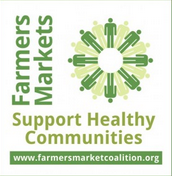Farmers Markets Support Healthy Communities
 Farmers Markets Support Healthy Communities
Farmers Markets Support Healthy Communities
In today’s fast-paced world, most Americans don’t know where their food comes from – let alone who grew it or how it was grown. Our connection to food has diminished to nothing more than a quick transaction at the check-out line, with no thought to who is behind the spinach in our salads or the steak on our grills.
Farmers markets reconnect communities to their food system. They create an opportunity where farmers can simultaneously sell fresh, local food and serve as food educators, revitalizing the way consumers shop and eat. They are places where farmers and neighbors meet to socialize and exchange ideas around cooking, nutrition, and agriculture. What produce is in season? What’s a healthy way to prepare asparagus? How do you raise your chicken? These answers can be found at a farmers market – answers that educate, inform, and build relationships between communities, farmers, and food.
Unlike other food retail outlets, farmers markets foster a sense of community among their customers. Not only do patrons shop for farm fresh food, but they also engage in conversation, meet neighbors for lunch, and enjoy the festive atmosphere with family and friends. Research indicates people thrive and are naturally happier when socially connected. Farmers markets support emotional health by creating a cheerful space where people come together for laughter, fellowship, food, and fun.
Just as importantly, farmers markets also support healthy lifestyles and diets. A 2012 study in Austin, Texas found that farm stands operating in low-income neighborhoods just one day a week increased the consumption of fruits and vegetables for families within walking distance. Another study conducted in North Carolina concluded that proximity to farmers markets was associated with lower body mass index (BMI) for local youth. By their presence alone, farmers markets are proven to positively impact the health and diet of their community, especially in areas that otherwise lack sufficient access to fresh, healthy food.
Availability of Farmers Markets and Farm Stands Is Associated with Health
- A 12-week study found that the placement of farm stands outside of community sites in low-income areas of Austin, Texas one day per week increased consumption of fruit and vegetables among people within walking distance. [i]
- The American Fitness Index includes the number of farmers markets per capita as a factor contributing to community health, using it as an indicator for community members’ access to fresh fruits and vegetables. [ii]
- Proximity to farmers markets was associated with lower body mass index (BMI) among North Carolina youth, while density of fast-food and pizza venues was associated with higher BMI. [iii]
Farmers Markets and their Programs Educate Shoppers and Improve Diets
- More than 3 in 5 farmers selling at farmers market talk with shoppers about nutrition and food preparation, educating people about healthy lifestyles and diets. [xi]
- NYC’s Health Bucks program was deemed a practice-tested health intervention by the CDC-funded Center for Health Promotion and Disease Prevention and an evidence-based strategy for environmental change by USDA SNAP-Ed. [iv]
- Low-income diabetic shoppers increased their fruit and vegetable intake by 1.6 servings per day using an incentive program based at a farmers market located at a health center.
- Over 90% of participants in Wholesome Wave’s Double Value Coupon Program agreed or strongly agreed that the amount of fresh fruits and vegetables that they purchased at farmers markets made a big difference in their family’s diet. [v]
- In 2012, New York City’s farmers markets distributed over $280,000 in Health Bucks, a health incentive coupon, to SNAP participants. Nearly three-quarters of Health Bucks users reported that the coupons made them more likely to buy fresh produce. [vi]
Farmers Markets Create Healthy Social Connections
- Farmers markets foster interactions among people of different race, class, age, and lifestyle. 28% of respondents surveyed about public markets said the greatest benefit of the market to the community is that it “Brings people together.” [vii]
- A comparison of shoppers at farmers markets and supermarkets shows that people shop in the company of others more frequently at farmers markets and have more social encounters. The correlation between health and social interaction implies that the social opportunities markets create provide important public health benefits. [viii]
- Studies of Los Angeles farmers market shoppers revealed that 55% felt the market increased their connection to community and 99% believed the market improves the health of the community. [ix]
- 7 in 10 farmers market shoppers said in a survey that they usually meet friends or acquaintances at the farmers market, turning the act of food purchasing into a vibrant social environment. [x]
